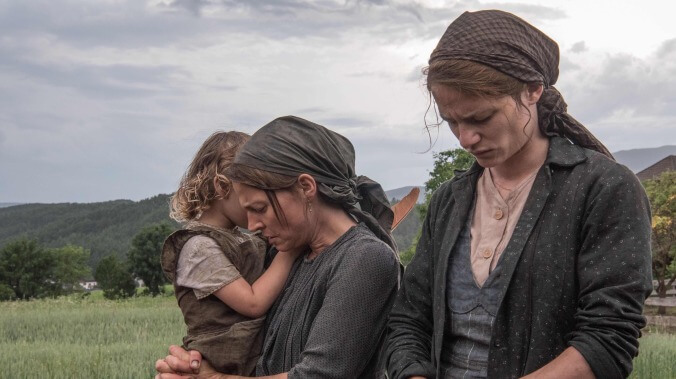Terrence Malick returns to the past and scripted drama, but not to form, with A Hidden Life

Rejoice, for Terrence Malick has written a screenplay again. After nearly a decade spent cobbling together improvised memory poems like To The Wonder and Knight Of Cups, this great American director has returned to the blueprint of narrative filmmaking, ready to tell something like a straightforward story again. But A Hidden Life (Grade: C+), the new three-hour biographical drama Malick premiered at Cannes yesterday, doesn’t operate all that differently than his recent, unscripted work. The camera still roves relentlessly, booming in close on the actors, bending the world around them like the fisheye of God. The action still unfolds in near-constant, fluttering montage. The characters still speak in awed voice-over, whispering their inner thoughts to each other or the Almighty. It’s not just that these devices have lost some of their novelty and mystery and power since Malick refined them into what could be called his mature style with his Cannes-winning The Tree Of Life. It’s that they may be an insufficient approach to this true story of moral defiance, however closely its details dovetail with the director’s interests.
The film’s real-life subject is Franz Jägerstätter, an Austrian farmer who became a conscientious objector during World War II, refusing to fight for Hitler and paying a big price for his courage of convictions. A Hidden Life presents his world and story in mythic terms. We meet Jägerstätter (August Diehl, doing a 180 from what may be his most well-known role as a wormy Nazi in Inglourious Basterds) in his home village of St. Radegund, which the film depicts as a hilly bucolic paradise, an Eden untouched by sin. Then, in one of Malick’s most effectively suggestive touches, Jägerstätter’s devoted wife, Franziska (Valerie Pachner), looks skyward to the offscreen hum of an airplane, filling the valley with the sound of an encroaching war and an approaching human evil.
Called to a nearby army base, Jägerstätter complies but not for long; he’s soon resolute in his conviction that to take up arms for the cause of Germany’s advance would be wrong. “It’s better to suffer injustice than to do it,” he concludes. What follows is essentially three hours of a pious man standing his moral ground, most of the world pressuring, imploring, and reasoning with him to get with the program. A Hidden Life is clear on the way a society will close ranks around dissent; it offers numerous, frankly repetitive scenes of the once-friendly townsfolk ostracizing Jägerstätter’s family, but also moments of more nuanced coercion, as various parties (including, rather improbably, a Nazi officer played by the late Bruno Ganz) attempt to talk sense into him, quite correctly noting that his stand will have no tangible, practical effect. (The film also demonstrates how the church was complicit, proving that this undeniably Christian artist isn’t reluctant to call out the failures of organized religion.)
Yet Malick doesn’t really articulate Jägerstätter’s moral realization. Watching in the dark, I couldn’t help but think of Schindler’s List, another WWII movie about awakening conscience from a giant of ’70s American cinema. For all its debated sentimentality, Spielberg’s film provided a clear, powerful context with the ghetto sequence, much of it shot from Schindler’s increasingly horrified perspective. In A Hidden Life, Malick yada-yada-yadas right through its protagonist’s moment of clarity—it’s practically just a quick shot or two in the endless churn of imagery—and he keeps the specifics of Jägerstätter’s objections awfully unspecified. (“We’re killing innocent people,” is about all the script can muster.) That’s in keeping with a film that, saving for an opening archival montage of Nazi Germany, largely abstracts the horrors of World War II, treating them as an unseen catalyst for its spiritual inquiry. It’s frankly a little troubling, seeing such a violent, devastating era reduced to another whispery ballet of nature. (The Thin Red Line, the director’s previous and vastly superior film about the war, offset the idyllic tranquility with chaos and horror.)
If this is supposed to be a study of internal crisis, Malick keeps us on the outside of it: One of the frustrating things about his characters is that they never stop speaking aloud their every thought but still often fail to convey the impression of an actual pathology. Here, we’re meant, I think, to see A Hidden Life as a story of a man fighting to stay true to his beliefs, but Malick never successfully suggests any real temptation or doubt—the sense that this spiritual rebel is in any danger of abandoning his principles to save his own life or spare his family the blowback. He remains nobly, resiliently true to his position, which makes A Hidden Life feel like a sermon, beatifying Jägerstätter as surely as the Catholic Church did. Me, I left wishing that someone like Scorsese, another living legend from the New Hollywood era, had found the real man, instead of just the saint, in this undeniably inspiring historical figure. Maybe Malick has committed so hard to his own principles, artistic as well as ideological, that he’s lost his grasp on drama. I’d love to see him step out of the church he’s built around his work and give us the world again, with or without a script.
Tomorrow: As expected, I’ve started falling behind on writing about everything I’m seeing. But I’ll catch up here with The Lighthouse, Robert Eggers’ bonkers follow-up to The Witch, starring Robert Pattinson and Willem Dafoe. Plus: the preemptively controversial new film from Jean-Pierre and Luc Dardenne, along with the hew highpoint of this year’s competition lineup, which is not a genre movie.